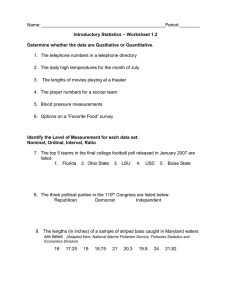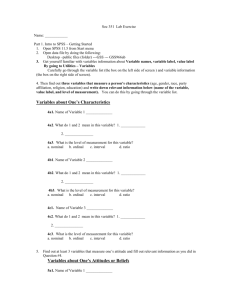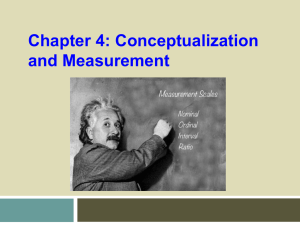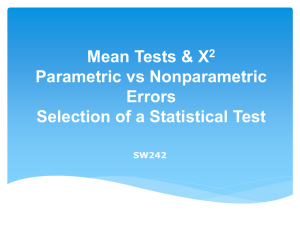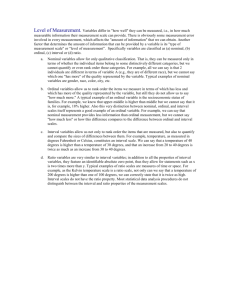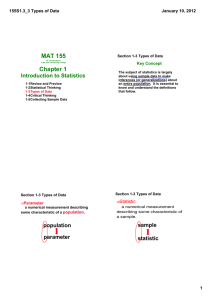TEMU XIII
advertisement
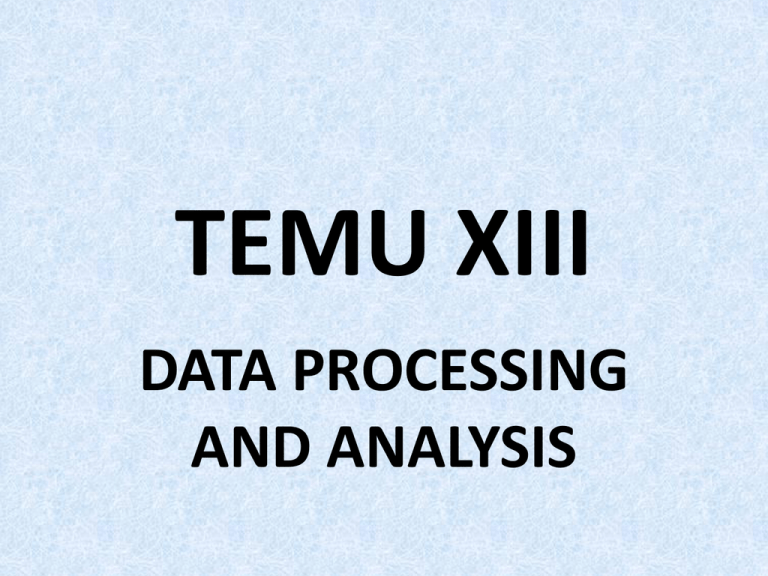
TEMU XIII DATA PROCESSING AND ANALYSIS The data, after collection, has to be processed and analyzed in according with the outline laid down for the purpose at the time of developing the research plan. This is essential for a scientific study and for ensuring that we have all relevant data for making contemplated comparisons and analysis. Technically speaking, processing implies editing, coding, classification and tabulation of collected data so that they are amenable to analysis. The term analysis refers to the computation of certain measures along with searching for patterns of relationship that exist among data-groups. Thus, ‘in the process of analysis, relationships or differences supporting or conflicting with original or new hypotheses should be subjected to statistical tests of significance to determine with validity data can be said to indicate any conclusions’. PROCESSING OPERATIONS 1. Editing is a process of examining the collected raw data to detect errors and omissions and to correct these when possible. ‘E’ involves a careful scrutiny of the completed questionnaires. ‘E’ is done to ensure that the data are accurate, consistent with other facts gathered, uniformly entered, as completed and have been well arranged to facilitate coding and tabulation. Field editing consists in the review of the reporting forms by the investigator for completing what the latter has written in abbreviated and/or in illegible form at the time of recording the respondent’s responses. This type of editing is necessary in view of the fact that individual writing style often can be difficult for others to decipher. This sort of editing should be done as soon as possible after the interview, preferably on the very day or on the next day 2. Coding process of assigning numerical or other symbols to answers to that responses can be put into a limited number of categories and classes. Such classes should be appropriate to the research problem under consideration. They must also process the characteristic of exhaustiveness and also that of mutual exclusively which means that a specific answer can be placed in one and only one cell in a given category set. Another rule to be observed is that of unidimensionality by which is meant that every class is defined in terms of only one concept. Coding is necessary for efficient analysis and through it the several replies may be reduced to a small number of classes which contain the critical information required for analysis. This makes it possible to precode the questionnaire choices and which in turn is helpful for computer tabulation as one can straight forward key punch from the original questionnaires. What ever method is adopted, one should see that coding errors are altogether eliminated or reduced to the minimum level. 3. Classification: Most research studies result in a large volume of raw data which must be reduced into homogenous groups if we are to get meaningful relationships. This fact necessitates classification of data which happens to be the process of arranging data in groups or classes on the basis of common characteristics. Data having a common characteristic are place in one class and in this way the entire data get divided into a number of groups or classes. Classification can be done one of the following two type, depending upon the nature of the phenomenon involved: a. Classification according to attribute Data are classified on the basis of common characteristics which can be either be descriptive (such as literacy, sex, honesty, etc.) or numerical (such as weight, height, income etc.). Descriptive characteristics refer to qualitative phenomenon which cannot be measured quantitatively; only their presence or absence in an individual item can be noticed. Data obtained this way on the basis of certain attributes are known as statistics of attributes and their classification is said to be classification according to attributes. Such classification can be simple classification or manifold classification. In simple classification we consider only one attribute and divide the universe into two classes –one class consisting of items possessing the given attribute and the other class consisting of items which do not possess the given attribute. Whenever data are classified according to attributes, the researcher must see that the attributes are defined in such a manner that there is least possibility of any doubt/ambiguity concerning the said attributes. b. Classification according to class-intervals. Unlike descriptive characteristics, the numerical characteristics refer to quantitative phenomenon which can be measured through some statistical units. Data relating to income, production, age, weight, etc. come under this category. Such data are known as statistics of variables and are classified on the basis of class interval. In this way the entire data may be divided into a number of groups or classes or what are usually ‘class interval.’ Classification according to class intervals usually involves the following: a. How many classes should be there? What should be their magnitudes? Some statisticians adopt formula suggested by Sturges, determining the size of class interval: I = R/(1 + 3.3 log N) I = size of class interval R = Range (i.e. the difference max & min values) N = Number of sample b. How to choose class limits? While choosing class limits, the researcher must take into consideration the criterion that midpoint o a class interval and the actual lower limit of a class and then divide this sum by 2 of a class interval and the actual average items of that class interval should remain as close to each other as possible c. How to determine the frequency of each class? This can be done either by tally sheets or by mechanical aids. Under the technique of tally sheet, the class-groups are written on a sheet of paper marked against the class group in which it falls 4. Tabulation When a mass of data has been assembled, it becomes necessary for the researcher to arrange the same in some kind of concise and logical order. Tis procedure is referred to as tabulation. Thus, tabulation is the process of summarizing raw data and displaying the same in compact form for further analysis. In a broader sense, tabulation is an orderly arrangement of data in coloms and rows Tabulation is essential because of the following reasons: a. It conserves space and reduce explanatory and descriptive statement to a minimum; b. It facilitates the process of comparison; c. It facilitates the summation of items and the detection of errors and omissions; d. It provides a basis for various statistical computations. ELEMENTS/TYPES OF ANALYYSIS By analysis we mean the computation of certain indices or measures along with searching for patterns of relation that exist among data group. Analysis involves estimating the values of unknown parameters of the population and testing hypothesis for drawing inference. It may be categorized as descriptive analysis and inferential analysis. Descriptive Analysis is largely the study of distributions of one variable. This will provide us with profiles of sample on any of multiple of characteristics such as size. We work out various measures that shows the size and shape of a distribution(s) along with the study measuring relationships between two or more variables. We may as well talk of correlation analysis and causal analysis. Correlation analysis studies the joint variation of two or more variables for determining the amount of correlation between two or more variable. Causal analysis is concerned with the study of how one or more variables affect changes in another variables. This analysis can be term as regression analysis. Causal analysis is considered relatively more important in experimental research, whereas in most social and business researches our interest lies in understanding and controlling relationships between variables then with determining causes per se and as such we consider correlation analysis as relatively more important. With the availability of computer facilities, there has been a rapid development of multivariate analysis. Inferential analysis is concerned with the various tests of significance for testing hypothesis in order to determine with what validity data can be said to indicate some conclusion(s). It is also concerned with the estimation of population values. It is mainly on the basis of inferential analysis that the task of interpretation (i.g., the task of drawing inference and conclusions) is performed. STATISTICS IN RESEARCH The role of statistics in research is to function as a tool in designing research, analyzing its data and drawing conclusions therefrom. Most research studies result in a large volume of raw data which must be suitably reduced so that the same can be read easily and can be used for further analysis. Clearly the science of statistics cannot be ignored by any research worker, even though he may not have occasion to use statistical methods in all their detail ramifications SUGGESTIONS TO USE STATISTICAL TESTING FAMILIRIZE YOUR DATA DATA CALCULATION DATA NOMINAL CALCULATION DATA (INDIFFERENCE) SEX NOMINAL TIME (INDIFFERENCE) DAY COLOR NOMINAL (INDIFFERENCE) CALCULATION ORDINAL (ORDER) DATA ORDINAL (ORDER) YES – NO EXTREMELY LIKE- LIKE - DISLIKE VERY DELICIOUS - DELICIOUS – NOT DELICIOUS VALUES SHOULD VARY BUT EQUAL DISTANCE NOMINAL (INDIFFERENCE) CALCULATION DATA ORDINAL (ORDER) NOMINAL (INDIFFERENCE) CALCULATION ORDINAL (ORDER) DATA MEASUREMENT INTERVAL NO ABSOLUTE (TEMPERATURE, PERCEPTION) MEASUREMENT INTERVAL NO ABSOLUTE (TEMPERTURE, PERCEPTION) MEASUREMENT RASIO ABSOLUTE (WEIGHT, HEIGHT) NOMINAL (INDIFFERENCE) CALCULATION ORDINAL (ORDER) DATA NOT ABSOLUTE (TEMPERATURE, PERCEPTION) UKUR ABSOLUTE (WEIGHT, HEIGHT) HOW TO EMPLOY A STATISTICAL TEST START TYPE OF DATA START NOMINAL / ORDINAL TYPE OF DATA ? START NOMINAL / ORDINAL TYPE OF DATA STATISTICS NON-PARAMETRIC START NOMINAL / ORDINAL TYPE OF DATA INTERVAL / RASIO ? STATISTICS NON-PARAMETRIC START NOMINAL / ORDINAL TYPE OF DATA INTERVAL / RASIO ? DISTRIBUTION OF DATA STATISTICS NON-PARAMETRIC START NOMINAL / ORDINAL TYPE OF DATA STATISTICS NON-PARAMETRIC INTERVAL / RASIO ? DISTRIBUTION OF DATA NOT NORMAL START NOMINAL / ORDINAL TYPE OF DATA STATISTICS NON-PARAMETRIC INTERVAL / RASIO ? DISTRIBUTION OF DATA NORMAL NOT NORMAL START NOMINAL / ORDINAL TYPE OF DATA STATISTICS NON-PARAMETRIC INTERVAL / RASIO ? DISTRIBUTION OF DATA NORMAL SAMPLE SIZE NOT NORMAL <30 (KECIL) START NOMINAL / ORDINAL TYPE OF DATA STATISTICS NON-PARAMETRIC INTERVAL / RASIO ? DISTRIBUTION OF DATA NOT NORMAL NORMAL SAMPLE SIZE >30 (LARGE) STATISTICS PARAMETRIC START NOMINAL / ORDINAL TYPE OF DATA STATISTICS NON-PARAMETRIC INTERVAL / RASIO ? DISTRIBUTION OF DATA NOT NORMAL NORMAL SAMPLE SIZE >30 (LARGE) STATISTICS PARAMETRIC SELECTING STATISTICAL TESTS TYPE OF DATA NOMINAL-ORDINAL INTERVAL - RATIO * STATISTICS PARAMETRIC HYPOTHESIS DESCRIPTIVE ( 1 VARIABLE) BINOMIAL c2 (1 SAMPLE) t-test (1 SAMPLE)* SELECTING STATISTICAL TESTS TYPE OF DATA NOMINAL ORDINAL - HYPOTHESIS COMPARING 2 SAMPLES INDEPENDENt FISHER EXACT c2 MEDIAN MANN WHITNEY - PROPORTION TEST – P* INTERVAL-RATIO T-TEST INDEPENDENT* * STATISTICS PARAMETRIC SELECTING STATISTICAL TESTS TYPE OF DATA NOMINAL ORDINAL HYPOTHESIS COMPARING 2 SAMPLES RELATED - PAIRED - MC NEMAR - SIGN TEST - WILCOXON - PROPORTION TEST – p* INTERVAL-RATIO T-TEST RELATED* * STATISTICS PARAMETRIC SELECTING STATISTICAL TESTS HYPOTHESIS TYPE OF DATA COMPARING 2 SAMPLES RELATED - PAIRED NOMINAL ORDINAL INTERVALRATIO - MC NEMAR - SIGN TEST - WILCOXON INDEPENDENT - PROPORTION TEST – P* - FISHER EXACT c2 - MEDIAN - MANN WHITNEY - PROPORTION TEST –P* T-TEST RELATED* T TEST INDEPENDENT* * STATISTICS PARAMETRIC SELECTING STATISTICAL TESTS TYPE OF DATA NOMINAL ORDINAL INTERVAL-RATIO HYPOTHESIS COMPARING >3 SAMPLES RELATED - PAIRED -c2 FOR K SAMPLE - COCHRAN Q - FRIEDMAN ANOVA* * STATISTICS PARAMETRIC SELECTING STATISTICAL TESTS TYPE OF DATA NOMINAL ORDINAL INTERVAL-RATIO HYPOTHESIS COMPARING >3 SAMPLES INDEPENDENT -c2 FOR K SAMPLE - MEDIAN EKST. - KRUSKAL WALLIS ANOVA* * STATISTICS PARAMETRIC SELECTING STATISTICAL TESTS HYPOTHESIS TYPE OF DATA COMPARING >3 SAMPLES RELATED - PAIRED INDEPENDENT NOMINAL ORDINAL -c2 FOR K SAMPLE -c2 FOR K SAMPLE - COCHRAN Q - MEDIAN EKST. - FRIEDMAN - KRUSKAL WALLIS INTERVALRATIO ANOVA* * STATISTICS PARAMETRIC ANOVA* SELECTING STATISTICAL TESTS TYPE OF DATA HYPOTHESIS ASSOCIATION NOMINAL-ORDINAL CONTINGENCY COEEFFICIENT C INTERVAL - RATIO - SPEARMAN RANK - PEARSON PRODUCT MOMENT CORRELATION* - SIMPLE REGRESSION ANALYSIS* - MULTIPLE REGRESSION ANALYSIS* * STATISTICS PARAMETRIC
